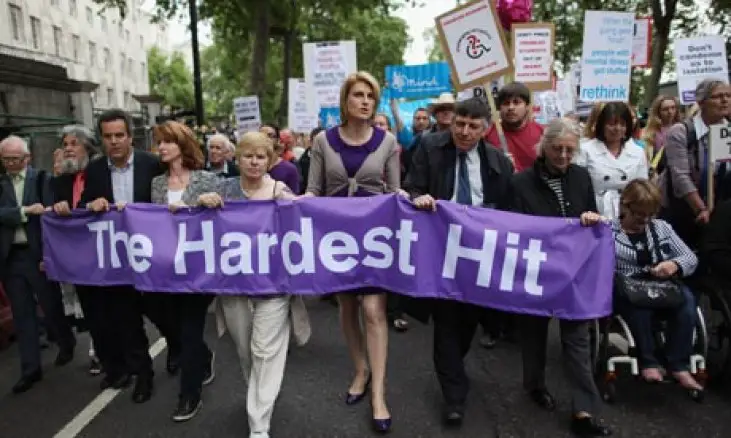
Employment and Support Allowance: plan to cut it defended
Last week the House of Lords voted against the government’s attempt to abolish the Work Related Activities Group for new claimants from the Employment and Support Allowance. This would have seen unemployed disabled and sick people’s weekly payments dropped from £102.15 to £73.10.
Research consultant and writer Clive Gilbert talks to Phil Reynolds, Co-chair of the Disability Benefits Consortium, and Dr Tom Shakespeare, who is involved in the disabled people’s movement in the UK and internationally, about what this means for disabled people.
The result not to cut a crucial part of the Employment and Support Allowance comes after an intensive lobbying campaign led by the Disability Benefits Consortium, a coalition of 60 charities working towards a fair benefit system. This included a major lobby day in January when around 150 disabled people came to Parliament to highlight their concerns.
Employment and Support Allowance
The purpose of the Employment and Support Allowance is to supplement the income of people who are either unable to work or are only capable of undertaking limited amounts of work. People who are assessed as belonging in the first group are allocated to the Support Group. Those who are deemed as having a limited capability to work are added to Work Related Activities Group, where they are expected to engage in training and other tasks that will eventually help them to land a job.
About 500,000 people currently receive the Work Related Activities Group component of the Employment and Support Allowance. They receive a higher weekly payment than people on Jobseeker’s Allowance in recognition of the fact that they are likely to face longer spells of unemployment.
Ministers argue that the extra money acts as a disincentive for recipients to find work. Speaking in the debate last week the Minister for Welfare Reform described the current situation as a; “fixation on welfare [that] treats the symptoms and not the causes of poverty. Over time, it traps people in dependency.”
Disability unemployment levels
The numbers of people employed with and without a disability are stark. According to the Department for Work & Pensions (DWP) only 45.9% of disabled people of working age in the UK are currently employed, compared to 79.4% of non-disabled people. The government has pledged to half the 33.5% difference, which has been labelled the Disability Employment gap.
The evidence that links the level of welfare payments to the amount of people unemployed is mixed. Those in favour of the cut point to research that has found people who can earn more on benefits than they would with their current set of skills in work are unlikely to sacrifice their income by finding a job. However, a study by the Joseph Rowntree Foundation in 2012 found that while the welfare system may influence some groups, the lack of available positions is a bigger cause of worklessness.
A review of the government’s Employment Support Allowance proposals by Baroness Grey-Thompson, Lord Low of Dalston and Baroness Meacher, concluded that there is little reason to believe that cutting benefits would incentivise Work Related Activity Group claimants to stay on it.
What the cut to Employment and Support Allowance could mean
Co-chair of the Disability Benefits Consortium Phil Reynolds says that the cuts are likely to have a; “significant, harmful impact on disabled people and their families.” The results of a survey of more than 500 existing claimants conducted by the Disability Benefits Consortium shows that; “almost half of respondents felt that the cut would probably mean they would return to work later, only 1% said the cut would motivate them to get a job sooner and almost 7 in 10 say cuts to ESA will cause their health to suffer
Mr Reynolds suggests that the Lords voted against the government because the; “strength of the argument that cutting financial support for disabled people who are too unwell to work will not fulfil the government’s goal of halving the disability employment gap. Instead, it would just move disabled people further from work and closer to or into poverty.”
The government is trying to square the circle of achieving its target of getting more disabled people into the world of work at a time of fiscal belt tightening. Sociologist Dr Tom Shakespeare of the University of East Anglia notes that; “the government has been seeking to reduce public spending overall, and by restricting spending on disability in particular.”
Dr Shakespeare contends that; “the challenge for radical groups who promote a social model understanding is that the government are using the rhetoric, saying they have removed the barriers, and now it’s up to disabled people to make an effort and work. However, [for] many disabled people, their health conditions prevent them working, or prevent them working to the same extent as non-disabled people. Therefore, the welfare system should recognise and support them.”
Instead of seeking to break the fabled link between the high levels of unemployment among disabled people and their reliance on the benefit system, disability activists say that the government should focus its energies on improving the effectiveness of employment programmes such as Access to Work and the Work Programme.
There is no single explanation for the economic inactivity of many disabled people. As Messrs Dalston, Meacher and Grey-Thompson recommend, support should be tailored to the individual. And more employers must be persuaded to open their doors to them.
By Clive Gilbert
Tell us what you think of this proposed cut to Employment and Support Allowance. Get in touch by messaging us on Facebook, tweeting us @DHorizons, emailing us at editor@disabilityhorizons.com or leaving your comments below.
One Comment